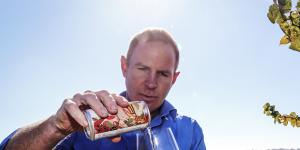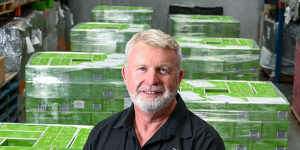Fifteen per cent of wine produced by Charles Sturt University’s winery in Wagga Wagga is packaged in cans in a bid to improve energy efficiency and reduce waste production.
The university’s winemaker Johnny Clark said cans used less energy than glass bottles to produce and transport and can be recycled “over and over”.

Charles Sturt University winemaker Johnny Clark said cans broaden the places where wine can be consumed.Stephen Moore
Other winemakers who also tout the environmental credentials of cans and say it does not compromise the quality of the wine.
Western Australian brand Small Things Wine only sells wine in cans,and chief winemaker Ian Batt said “tinnies” were not just for cheap wine.
“We are a premium wine producer,and it’s our goal to raise people’s expectations not to lower them,” he said.
Batt said cans reduce the risk of air and light coming into contact with wine and causing a loss in quality and premature ageing.

Baroke Wines chief executive Greg Stokes said the company had successfully exported wine in cans to overseas markets in Europe and Asia.Eddie Jim
“Our cans are like little time capsules,capturing the terroir and vintage of that year without a loss in quality,” he said.
Clark said regular blind tastings of canned and bottled wine had not revealed a discernible difference in taste.
“There is certainly no ‘tinny’ taste to the cans,” he said.
“I don’t think anyone is buying a can to lay down (to age),as you may a Coonawarra cabernet.”
Wine drinkers are not convinced,with tinnies making up less than 1 per cent of retail sales in 2023 compared to 7 per cent for cask wine.
A Wine Australia spokeswoman said sparkling wine made up more than 90 per cent of the canned category,but declined in 2023.
Wine Australia last year released its guide to reduce carbon emissions in the wine sector,which includes switching to lighter-weight glass bottles and other alternatives.
“However,generally cans are less energy intensive to produce than glass and are lighter to transport,which saves emissions for the sector,” the spokeswoman said. “They may also be generally easier to recycle than glass in current household collection systems.”
Barokes Wines packages different varietals of wine in a patented can,which chief executive Geoff Stokes said have a shelf life of at least 12 months.
“Some ageing does occur,” he said. “However it is much slower than wine ageing in glass bottles with either cork or screw cap enclosures.”
Stokes said the company had successfully exported wine cans to overseas markets in Europe and Asia.
“The Japanese are very used to consuming premium quality products in a can;hence there were no preconceived ideas about the quality of the wine in the can,” he said.
Seven types of canned wine are sold at Coles Liquor outlets,including prosecco,sangiovese rose spritz and pinot grigio spritz.
“While sales of canned wine make up a small proportion of our overall wine sales,the category is growing in popularity as more of our customers enjoy the added convenience without any compromise to drinking quality,” a Coles Liquor spokeswoman said.
Endeavour Group’s head of commercial Wine Leigh Firkin said the market for canned wine was growing steadily:“All wine can be put in cans,but customers prefer lighter styles such as prosecco and rose.”
Firkin said customers sought out wine in cans to drink in places where glass is not permitted.
“It’s also great for portion control for those looking to moderate their intake,” she said.
Charles Sturt University’s tinnies contain up to 2.8 standard drinks in a 250 ml can of Grenache Shiraz,which Clarke said was “the top end of what is on offer in cans”.
“The tendency to drink a can as if you’re in a 80s Solo ad is not advisable,” he said. “A more measured approach would be to pour the wine into a glass.”
Clark said canned wine might lead to more moderate alcohol consumption:“A consumer may feel obliged to finish a bottle once opened,whereas a can is single use – you could call it portion control.”
Stokes said cans will never replace a bottle of wine in a fine dining setting,but broadens the places where wine can be consumed.
“Our aim as the pioneers of wine in a can globally was to make wine portable,to be consumed when and where the consumer wished to take it,for example,camping,hiking,picnics,beach,poolside,flying,golf,” he said.